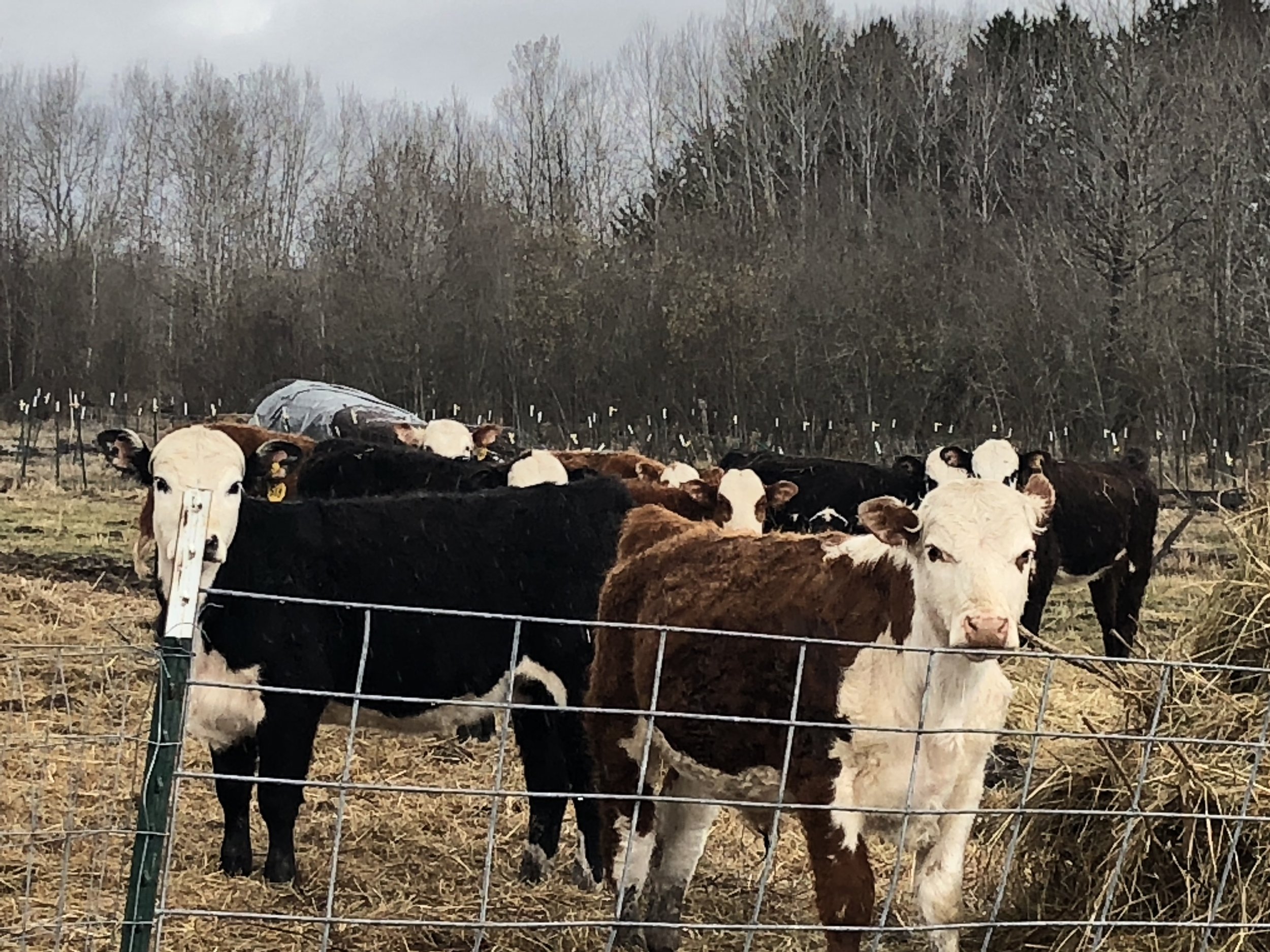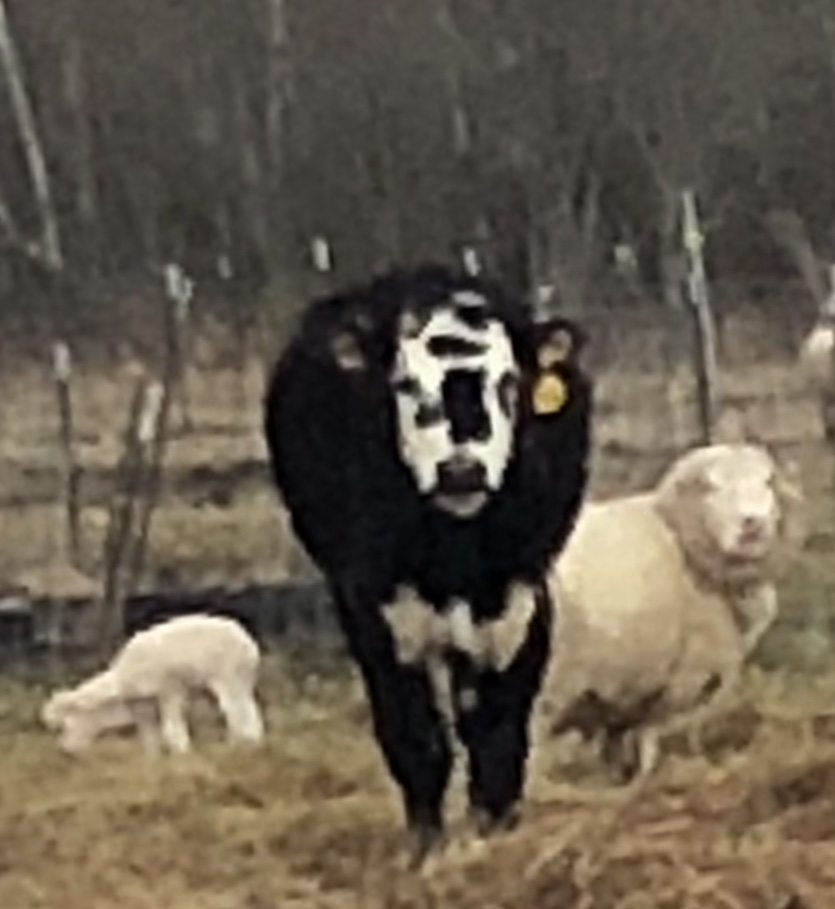This is the third in a series of articles telling the story of Iron Range farmers and growers who can feed us. Recently I spent the day at Willow Sedge Farm. The most common native plants on this farm are willow and sedge, hence the name “Willow Sedge Farm.” I’ve been buying grass fed beef and pastured pork and chickens from Jane Jewett for several years now, and I had always wanted to visit her farm. “Bring knee high mud boots” she advised, and I’m glad I did. It had been raining off an on for over a week, and the potholes in the gravel driveway were muddy and deep. The journey from Virginia took me down along the Mississippi in the very early spring. I grew up along the Mississippi in Rock Island, Illinois, and reconnecting with the great river always feeds my soul. I stopped in Jacobson at the landing to just sit by the river for a bit; it was way out of its banks.
Jane Jewett grew up on a farm and has lived on one all her life except when finishing her degrees, a B.S. in agronomy and an M.S. in plant breeding. She breeds mostly animals these days and I got to meet many of them. New chicks had just arrived and Jane had them in a heated coop. They were going to be introduced to the great outdoors in a few days using a protected enclosure right outside of their cozy nursery. A number of the other coops had collapsed in the heavy snow last winter and were in various stages of being rebuilt. By the end of the summer, Jane will have produced 150 meat chickens. She restricts her flock to females because “they don’t fight with each other.” The fourteen adult laying hens were free-ranging and we ran into them everywhere. Jane has to fence in the rhubarb and veggies near the house to keep them for the humans. The hens were busy pecking bugs out of last year’s leaves as we walked around.
A baby lamb just weaned from the bottle let us know that he was not happy about that. He was hanging around with several adult sheep still in their heavy winter coats. (The sheep are Jane’s daughter’s project. A couple of years ago they had the wool processed and offered it for sale at the local farmers market. The color of pure cream, this wool looked and felt wonderful, but it didn’t sell well. The mutton sold much better.) The sheep graze on a cover crop of oats, field peas, turnips and sunflowers in season. Jane says when her daughter goes to college, she likely won’t have sheep anymore. So many animals to care for here.
Despite the mud, about a dozen yearling cattle look clean and happy in their large enclosure. The cattle winter in a pole barn with an automatic waterer and access to the outside all the time. “Weather-dependent” winter grazing allows them to range over a large area until it snows enough to cover the grass. Jane says they come up to the gate by the house to let her know when they need hay. Right now, the pole barn is home to the other dozen members of the herd, all of them cows who will calve this spring. As of this writing, seven calves have arrived.
The rest of the year, Jane uses “adaptive multi paddock grazing” also known as AMP which research has shown is more friendly to the environment than traditional grazing. An analysis in the journal “Progressive Farmer” explains “Ruminants, particularly beef cattle, are perceived by many as a problem since they are a source of greenhouse gas (GHG) due to the methane produced by rumen fermentation. Richard Teague, professor of ecosystems science and management at Texas A&M University, and colleagues Seong Park and Tong Wang examined the possibility of reducing the net carbon footprint of ruminants using improved grazing. The adaptive multi-paddock grazing is more environmentally friendly, because it results in more carbon sequestration in the soil. In fact, the higher-quality grass produced by using this method actually reduces the methane gas emitted from the cows. Teague explained that by using this method of grazing and keeping the plants leafy, it results in a higher quality of nutrition for cattle. The cattle can digest the higher-quality grass more quickly, which lowers the amount of methane gas they emit. Teague explained that by managing rangeland in this way, the amount of bare ground is also reduced. Since bare ground causes loss of carbon from the soil into the air, more living plants covering the ground minimized carbon losses.” So not all grass-fed cattle have the same impact on the planet, I learned.
It was too muddy to walk or drive across the farm through all of the grazing paddocks, so we sat at Jane’s kitchen table and looked at a map of the farm. It spans acreage that crosses a road. On the side with the barn, she moves the cattle every day or two, pushing them ahead down large lanes radiating out from the barn, opening up a fresh grazing area by removing the fence in front of them. This way the cattle have access to water and shade behind them and paddocks of fresh forage ahead of them. The grazing fence is electric, and the cattle are used to the fences and the regular movement. It takes about 45 days for a paddock to re-grow when it’s been grazed. With 113 acres, there’s plenty to graze. And it takes about 18 months to get a full-grown animal. The cattle graze a blend grasses, clover and birds foot trefoil which grows wild in most of Minnesota. On the other side of the road are similar lanes of paddocks with an “alley” at each end for turning. On this side, Jane has to bring water—in her 550-gallon water wagon. Rotational grazing is hands-on work!
Cutest face ever, eh?
The farm’s ten sows and one boar roam and root, but they’re also fed a combination of alfalfa pellets, oats, a protein supplement, and corn. And, let me tell you, that combination results in amazing bacon! We approach the fence near the feeder and they come to say hello. Jane scratches the boar’s ears and he grunts gratefully. The pigs’ job right now is to till and fertilize a field that will eventually grow corn and squash and beans. Pigs are consummate tillers, their hooves perfectly shaped for breaking ground. The huts that kept them warm this winter are largely abandoned now as they bask in the spring weather.
Jane and her husband have built both of the log houses on the farm, moving from the small one, now a shop, when their family outgrew it. The chickens and sheep are closer to the house where a dog is tasked with keeping watch for predators. Predators on the farm have included bears, skunks, coyotes, foxes, timberwolves, owls and raccoons. The other abundant wildlife--deer, geese, wild turkeys and sandhill cranes were all evident as I drove down the Great River Road.
Jane has farmed here since 1994, but her grandfather began farming here in 1923. Her brother farms up the road. The land changed hands a few times, but has largely been in the family. Jane says that, when you grow up moving cattle on pasture like she did, you learn to assess the health of an animal easily. That skill is something she uses every day. And the animals here at Willow Sedge show it. Both Jane and her husband have off-farm jobs and her husband also does some logging, but the farm is all Jane’s.
She faces the same challenge that most area livestock farmers face: the lack of a USDA processing plant nearby. Transporting livestock several hours to Foley or Swanville or Sturgeon Lake is a time-consuming and labor-intensive expense. This highlights one of the missing pieces of a complete food system on the Range. We also have very few value-added food processors in northern Minnesota. Building a local food system step by step is what’s necessary to feed ourselves. We have the land and the growing season to raise the food we need to be self-sufficient. But we have work to do encouraging new farmers and growers, advocating for the missing elements, and pledging to buy local food whenever we can to make this a reality.




